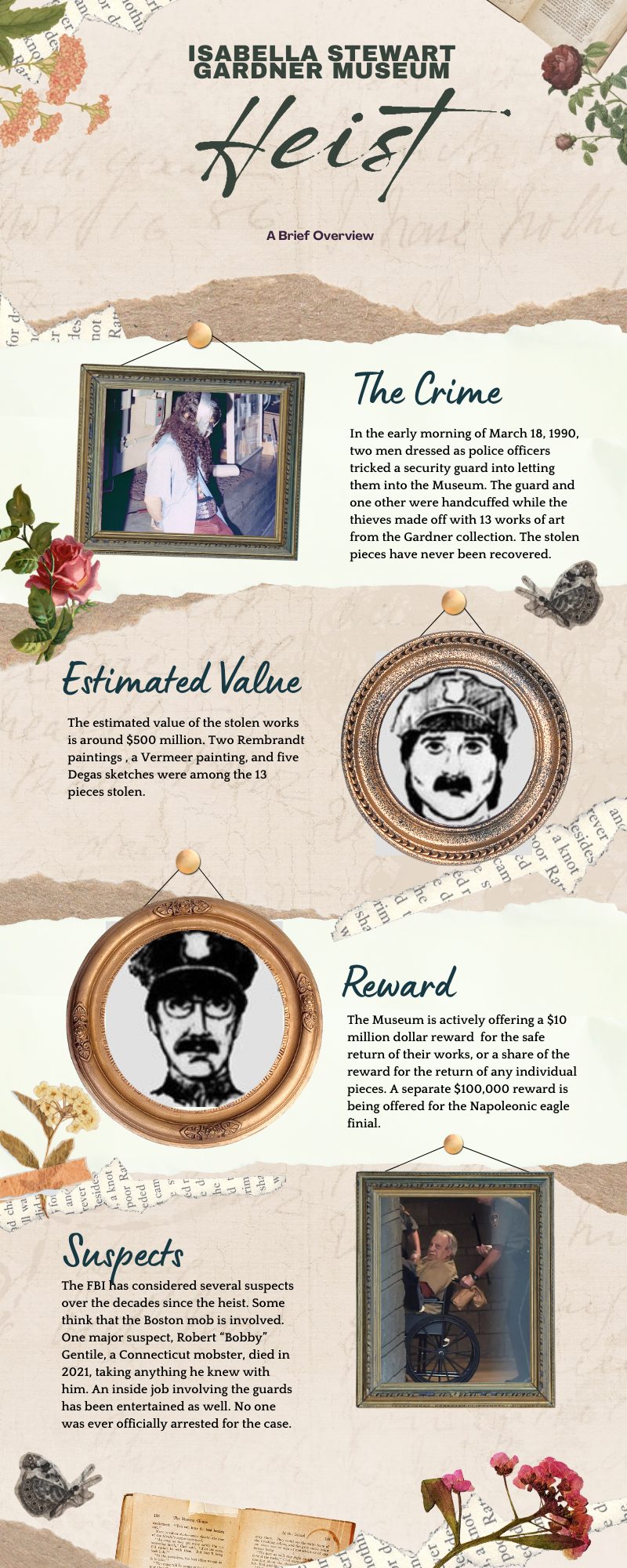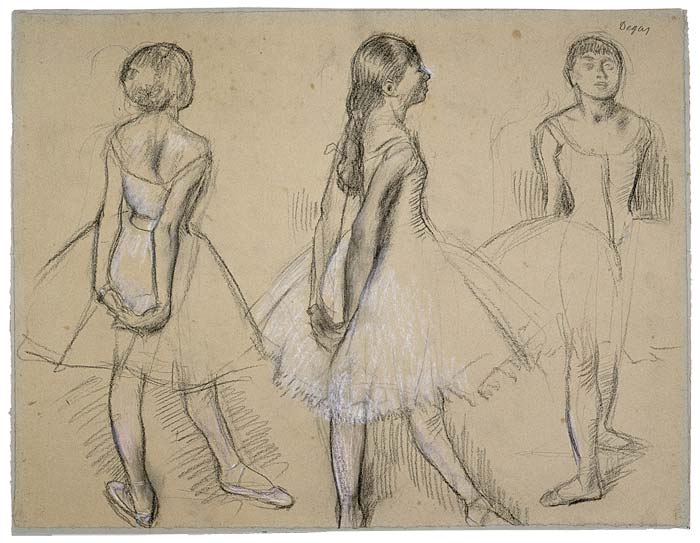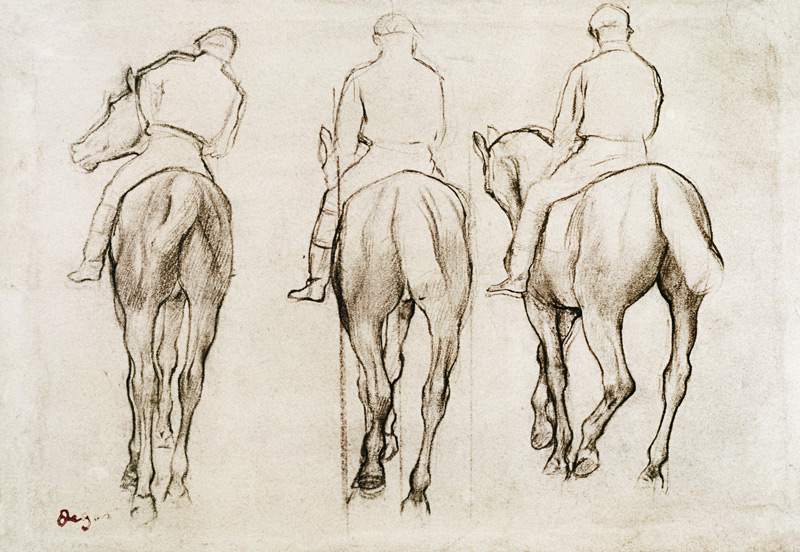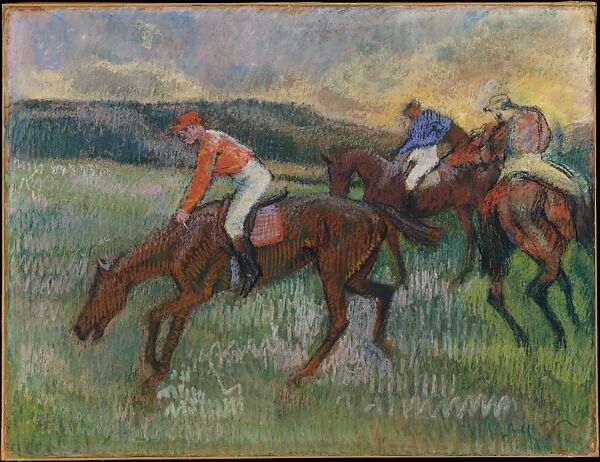Forging a painting missing for 35 years
Leaving the Paddock (La Sortie Du Desage)
Artist: Edgar Degas (Paris, 1834-1917)
Material/Medium: Watercolor and pencil on paper
Dimensions: 10.5×16 cm
Accession Number: 3.1.0.94
Location: Unknown


Why forge this painting?
Combined, the five Edgar Degas sketches stolen, including Leaving the Paddock, were only worth around $100,000. If this worth is split evenly between the five sketches, the Leaving the Paddock would be worth around $20,000. I would argue, though, that because of the infamous heist, the sketch would be worth more now. The motive is simple: money. Art forgery is a hard crime to convict, especially if it cannot be proven with unreasonable doubt. Even then, the punishment is generally only a few years in prison, if it even makes it to trial in the first place. In theory, this would be an easy $200,000 reward. The museum, exposing the forgery or not, gets more headlines, and really would profit off it, so who is actually the victim here?
How to Forge the Perfect Crime


The Stamp
The official description of Leaving the Paddock says that his signature is stamped in red ink. Thanks to some Degas experts, there are several photos of this red ink stamp that his estate used on some of his works, including Leaving the Paddock, it seems. They also note, on the back of some of his work, a second “Atélier Degas” stamp in black ink was used. These authentication stamps were used by Edgar Degas estate after his death, and it seems his signature is nowhere else on the original painting. A stamp signature is only a secondary supporting detail of authenticity, but I’m detail oriented.
Watercolor
The convenient part of forging Leaving the Paddock in particular, is that it is watercolor. Watercolor is really hard for experts to authenticate, since watercolor only leaves small amounts of paint on the canvas. Experts would need to use forensic testing to see the sketch underneath the watercolor and carbon date the paper. I’ve worked with watercolor in the past, and it doesn’t behave exactly how you want it to, but I can see from the photo of Leaving the Paddock, where more or less water would need to be applied. It isn’t hard to find watercolor paints and brushes from the nineteenth century to use. It only took one quick Internet search for me to find places to buy these antique supplies. The paints would help pass any chemical analysis done or spectroscopic analysis to look at the makeup of the paints and the colors.
While the official description of the painting doesn’t say it, my own look at the painting makes me think the white highlights were done with white pastel chalk. Degas did use pastels in other works, so I don’t believe it’s a huge jump to say he used pastel in Leaving the Paddock. This attention to detail could save the authenticity test. I would need to get the accurate aged pastel chalk as well to use.
Paper
Getting the paper would not be too difficult, this painting was done in the nineteenth century. I would just need to find a book printed during that time period that has a blank page, and the dimensions wouldn’t be hard to find. Considering this “painting” has been in the back of another frame for years, it wouldn’t be suspicious if the paper was a little more worn than when Leaving the Paddock first went missing.
Sketch
The real work would come down to the sketch itself. Thankfully, Leaving the Paddock, is not a super difficult piece to mimic. This painting shows a lot of the sketch layer and has the appearance of being unfinished. It might take a few tries, but it wouldn’t be impossible to create a hasty sketch layer before the watercolor.
Imitating Edgar Degas’ style of sketches would take some time to learn. Degas had a good understanding of bodies and movement, and this reflected in his work, even with a minimal detail sketch like Leaving the Paddock. I would need to study not just his sketches, but develop my own skill as well, to mimic the ease of which Degas sketched.
Provenance
To fake provenance and ownership history following the heist, it’s easiest to keep it as simple as possible and minimize the trail. There are no current tips as to where Leaving the Paddock is, but when people die, their belongings tend to get searched through. One suspect, Robert ‘Bobby’ Gentile, a Connecticut gangster and suspected mafia member, died in 2021. His possessions have probably been either given to living family, or put in an estate sale. Personally, if he was not involved in the heist, I would feel bad ruining a dead man’s name even more, but I’m not an actual criminal forging an art piece here.
That aside, I am putting up a huge hypothetical here, Gentile dies, his belongings are scattered, but of course, not before they are searched for any of the missing artworks that some claimed he had. A distant cousin claims to have ended up with a random art print from Gentile that has Leaving the Paddock, hiding on the back of the frame. It’s not too outlandish to think that if the FBI had searched, that they missed it entirely. Leaving the Paddock is barely bigger than a postcard and easy to hide behind a frame. It wouldn’t be unlikely that if Gentile, however he ended up with Leaving the Paddock, would realize it’s too hot to sell and hide it.
Since there is a short and lack of paper trail, the law would not be able to track who initially sold the painting or had it after it was stolen, and all the other missing pieces of art couldn’t be tracked down. The FBI already suspected that Robert ‘Bobby’ Gentile was involved in the heist, so they would probably be happy to have a name. I am assuming that after the authentication of Leaving the Paddock, the FBI would be passive about the case again.
Degas’ Style





The Results (Hopefully!)
The crime is committed perfectly. The painting is authenticated and given to the Isabella Stewart Gardner Museum, and they award me $200,000 for the return. I would assume initial authentication would be paid by the museum, as they do have $10 million to offer as a reward. To avoid any more scrutiny, I would be happy to take the $200,000 and drop off the radar following the return of the piece. In this case, I will just continue to hope that the original Leaving the Paddock never reappears, if it does, they have some questions to answer. Perhaps, Gentile’s old suspected connections would take notice of my work, and offer me some job opportunities in the art crime market. In the end, this crime would serve as a great way of networking.
Works Cited
Cascone, Sarah. “Robert ‘Bobby’ Gentile, Long Fingered by the FBI as a Suspect in the 1990 Isabella Stewart Gardner Museum Heist, Dies at 85”. https://news.artnet.com/art-world-archives/gardner-heist-suspect-robert-gentile-2012506. 2021.
Degas Experts. https://degasexperts.com/index.php
Fletcher, Shelley, and Pia Desantis. “Degas: The Search for His Technique Continues.” The Burlington Magazine, vol. 131, no. 1033, 1989, pp. 256–65. JSTOR, http://www.jstor.org/stable/883834.
Growe, Bernd. Edgar Degas, 1834-1917. Taschen. 2001.
Isabella Stewart Gardner Museum. https://www.gardnermuseum.org/experience/collection/14028
Isabella Stewart Gardner Museum. https://www.gardnermuseum.org/organization/theft
Kurkjian, Stephen. Master Thieves: The Boston Gangsters Who Pulled Off the World’s Greatest Art Heist. PublicAffairs. 2015.
Ragai, Jehane.“The Scientific Detection of Forgery in Paintings.” Proceedings of the American Philosophical Society, vol. 157, no. 2, 2013, pp. 164–75. JSTOR, http://www.jstor.org/stable/24640239.
Reff, Theodore. “The Technical Aspects of Degas’s Art.” Metropolitan Museum Journal, vol. 4, 1971, pp. 141–66. JSTOR, https://doi.org/10.2307/1512619.
Zorić, Vojkan M. & Petrović, Vesna. “Determination of Forgery Paintings in the Watercolor Technique-Case Study”. Security Horizons. 2022. https://www.researchgate.net/publication/372381512_DETERMINATION_OF_FORGERY_PAINTINGS_IN_THE_WATERCOLOR_TECHNIQUE_-_CASE_STUDY
